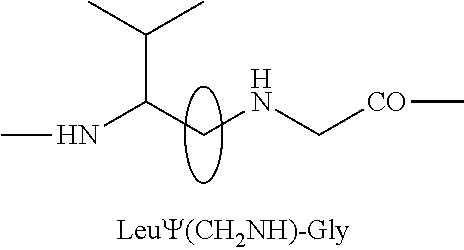177 lutetium-labeled bombesin analogs for radiotherapy
- Summary
- Abstract
- Description
- Claims
- Application Information
AI Technical Summary
Benefits of technology
Problems solved by technology
Method used
Image
Examples
example 1
Binding Affinity to GRPr and Serum Stability Binding-Affinity Measurements
[0124]The binding-saturation experiments were performed using increasing concentrations of the compound 2 [177 / natLu] and compound 3 [111 / natIn] ranging from 0.1 to 1,000 nmol / L. For the blocking experiments 0.8 mmol / L of blocking agent was used. For each radioligand, triplicates were prepared for every concentration, for both total binding and nonspecific binding. Before adding the radioligands to the wells, the plates were placed on ice for 30 min. After adding the specific blocking agents and radioligands, the plates were incubated for 2 h at 4° C. After this time interval, the binding buffer was aspirated and the cells were washed twice with ice-cold phosphate-buffered saline (PBS, pH 7.4); this represented the free fraction. The cells were then collected with 1 N NaOH; this corresponded to the bound fraction. Specific binding was calculated by subtracting non specific binding from total binding at each co...
example 2
Biodistribution of Compound 2 in PC-3-Bearing Mice at Time 1 h, 4 h, 24 h, 48 h and 72 h
[0127]Biodistribution was investigated in NMRI nude mice bearing subcutaneous PC-3 tumors in the right hind limb at different time-points. Body weight of the male mice was approx. 30 g, 3 animals were investigated per time-point. After injecting an intravenous dose into the tail vein, mice were sacrificed at indicated time points and dissected organs were analyzed by radioactive counting. An administration dose of 100 μL was applied per animal with a mean activity of 86 kBq.
[0128]At indicated time points urine and feces were quantitatively collected. At the same time points, animals were sacrificed and exsanguinations under isoflurane anesthesia and the following organs and tissues were removed for measurement of [177Lu] using the gamma-counter: spleen, liver, gallbladder, kidneys, lung, femur, heart, brain, fat, thyroid, muscle, skin, blood, tail, stomach (without content), prostate, intestine (...
example 3
[0130]The biodistribution data of compound 2 in PC-3-tumor bearing mice (see example 2) were used for dosimetry calculations by the MIRD (Medical Internal Radiation Dosimetry) methodology to estimate mouse-organ self-to-self doses. Time activity (kinetic) data were modeled to produce the residence times for compound 2.
[0131]Dosimetry calculated by the Medical Internal Radioation Dose (MIRD) methodology showed an excellent therapeutic window in mice (regarding kidneys and pancreas). Doses of 150-200 Gy in the tumor could be achieved considering a maximum activity of 450 MBq to be injected per animal. Kidneys were not critical instead it was the pancreas to be the dose limiting organ. (In contrast to rodent pancreas, human pancreas expresses only very low amounts of the GRPr.)
See FIG. 3
PUM
| Property | Measurement | Unit |
|---|---|---|
| Fraction | aaaaa | aaaaa |
| Therapeutic | aaaaa | aaaaa |
| Pharmaceutically acceptable | aaaaa | aaaaa |
Abstract
Description
Claims
Application Information
 Login to View More
Login to View More - R&D
- Intellectual Property
- Life Sciences
- Materials
- Tech Scout
- Unparalleled Data Quality
- Higher Quality Content
- 60% Fewer Hallucinations
Browse by: Latest US Patents, China's latest patents, Technical Efficacy Thesaurus, Application Domain, Technology Topic, Popular Technical Reports.
© 2025 PatSnap. All rights reserved.Legal|Privacy policy|Modern Slavery Act Transparency Statement|Sitemap|About US| Contact US: help@patsnap.com



